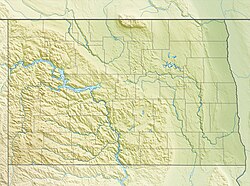Demographics
According to realtor website Zillow, the average price of a home as of August 31, 2025, in Beulah is $240,416. [11]
As of the 2023 American Community Survey, there are 1,231 estimated households in Beulah with an average of 2.39 persons per household. The city has a median household income of $84,417. Approximately 8.3% of the city's population lives at or below the poverty line. Beulah has an estimated 57.1% employment rate, with 19.8% of the population holding a bachelor's degree or higher and 89.3% holding a high school diploma. [12] There were 1,636 housing units at an average density of 669.67 per square mile (258.6/km2).
The top five reported languages (people were allowed to report up to two languages, thus the figures will generally add to more than 100%) were English (94.2%), Spanish (0.8%), Indo-European (4.0%), Asian and Pacific Islander (0.5%), and Other (2.3%).
The median age in the city was 37.0 years.
Beulah, North Dakota – racial and ethnic composition
Note: the US Census treats Hispanic/Latino as an ethnic category. This table excludes Latinos from the racial categories and assigns them to a separate category. Hispanics/Latinos may be of any race.| Race / ethnicity (NH = non-Hispanic) | Pop. 1980 [13] | Pop. 1990 [14] | Pop. 2000 [15] | Pop. 2010 [16] | Pop. 2020 [17] |
|---|
| White alone (NH) | 2,838
(97.59%) | 3,234
(96.16%) | 3,007
(95.4%) | 2,934
(94.01%) | 2,726
(89.14%) |
| Black or African American alone (NH) | 6
(0.21%) | 7
(0.21%) | 1
(0.03%) | 7
(0.22%) | 29
(0.95%) |
| Native American or Alaska Native alone (NH) | 51
(1.75%) | 91
(2.71%) | 53
(1.68%) | 58
(1.86%) | 44
(1.44%) |
| Asian alone (NH) | 2
(0.07%) | 8
(0.24%) | 9
(0.29%) | 8
(0.26%) | 20
(0.65%) |
| Pacific Islander alone (NH) | — | — | 20
(0.63%) | 8
(0.26%) | 0
(0.00%) |
| Other race alone (NH) | 0
(0.00%) | 1
(0.03%) | 3
(0.10%) | 0
(0.00%) | 5
(0.16%) |
| Mixed race or multiracial (NH) | — | — | 44
(1.40%) | 35
(1.12%) | 119
(3.89%) |
| Hispanic or Latino (any race) | 14
(0.48%) | 22
(0.65%) | 15
(0.48%) | 71
(2.27%) | 115
(3.76%) |
| Total | 2,908
(100.00%) | 3,363
(100.00%) | 3,152
(100.00%) | 3,121
(100.00%) | 3,058
(100.00%) |
2020 census
As of the 2020 census, there were 3,058 people, 1,232 households, and 805 families residing in the city. [18] The population density was 1,251.74 inhabitants per square mile (483.3/km2). There were 1,560 housing units at an average density of 638.56 per square mile (246.5/km2). The racial makeup of the city was 90.12% White, 0.95% African American, 1.57% Native American, 0.65% Asian, 0.00% Pacific Islander, 1.28% from some other races and 5.43% from two or more races. Hispanic or Latino people of any race were 3.76% of the population. [19]
2010 census
As of the 2010 census, there were 3,121 people, 1,353 households, and 862 families residing in the city. The population density was 1,252.41 inhabitants per square mile (483.6/km2). There were 1,508 housing units at an average density of 605.14 per square mile (233.6/km2). The racial makeup of the city was 94.78% White, 0.22% African American, 2.31% Native American, 0.26% Asian, 0.26% Pacific Islander, 0.74% from some other races and 1.44% from two or more races. Hispanic or Latino people of any race were 2.27% of the population.
There were 1,353 households, of which 26.8% had children under the age of 18 living with them, 55.1% were married couples living together, 4.7% had a female householder with no husband present, 3.9% had a male householder with no wife present, and 36.3% were non-families. 31.9% of all households were made up of individuals, and 12.1% had someone living alone who was 65 years of age or older. The average household size was 2.24 and the average family size was 2.81.
The median age in the city was 44.2 years. 22.3% of residents were under the age of 18; 6.4% were between the ages of 18 and 24; 22.1% were from 25 to 44; 34.3% were from 45 to 64; and 14.9% were 65 years of age or older. The gender makeup of the city was 51.3% male and 48.7% female.
2000 census
As of the 2000 census, there were 3,152 people, 1,213 households, and 851 families residing in the city. The population density was 1,307.88 inhabitants per square mile (505.0/km2). There were 1,475 housing units at an average density of 612.03 per square mile (236.3/km2). The racial makeup of the city was 95.78% White, 0.03% African American, 1.68% Native American, 0.29% Asian, 0.63% Pacific Islander, 0.16% from some other races and 1.43% from two or more races. Hispanic or Latino people of any race were 0.48% of the population.
The top six ancestry groups in the city are German (74.3%), Norwegian (12.3%), Irish (9.3%), Russian (7.7%), English (3.4%), Czech (2.3%).
There were 1,213 households, of which 39.9% had children under the age of 18 living with them, 61.0% were married couples living together, 6.8% had a female householder with no husband present, and 29.8% were non-families. 27.8% of all households were made up of individuals, and 12.9% had someone living alone who was 65 years of age or older. The average household size was 2.53 and the average family size was 3.09.
The median household income was $45,256 and the median family income was $54,700. Males had a median income of $50,870 versus $20,792 for females. The per capita income for the city was $18,614. About 5.3% of families and 7.8% of the population were below the poverty line, including 4.6% of those under age 18 and 30.0% of those age 65 or over.








